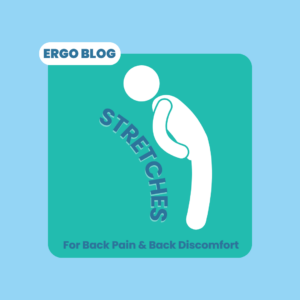Updated: Feb 9, 2023
Ergonomics for Dental Workers
There is great appreciation for workers in the field of dentistry. Most of the hours of the workday for a dental worker include looking inside of our mouths while holding onto a small hand tool. Because the area of focus, our mouth, is quite small, the job does not automatically encourage dental workers to move around. There are solutions that are outlined below.
12 Ergonomic Solutions for Dental Workers
- Maintain a neutral position. When working with a patient, remain at the top of the patient’s crown. This will allow you to maintain a neutral neck and spine with forward facing hips, knees, and feet.
- Communicate with your patient. Talk to your patient about positioning needs throughout your time with them. While keeping the patient comfortable, ask the patient to move their head or neck in a way that would benefit you versus you leaning more or reaching more to complete a job task. If you do have to work at a patient’s side, for example, their right, ask them to move close to the right edge of the chair. This will help to reduce your extended reach for you.
- Use vision adaptations. Using loupes, ergonomic loupes, a ceiling mounted microscope, and adequate lighting can allow you to remain in an upright position while eliminating or reducing forward trunk bending or flexion. Our posture will allow following our vision. If we are not able to see something clearly, we will automatically lean forward for a better view.
- Tilt the seat pan of your stool forward or slightly downward. Many times, dental workers have a stool set at a height where their hips are higher than their knees. To reduce excessive hip flexion, slightly tilt the seat pan downward. This will open the hip angle and provide a better posture when leaning forward.
- Use arm supports when possible. Supporting the weight of our arms with armrests can help reduce the amount of weight that is distributed to our back and hips and lower extremities.
- Keep commonly used tools close by. The average maximum reach distance is around 12 inches. This distance will vary based on worker heights. Having hand tools close by will help reduce extended reach. Less frequently used tools can be positioned further away.
- Check hand tool/working instrument weight and thickness. Aim for using an instrument that has a diameter of 10 mm, and one that is lightweight at 15 grams. Meeting these specifications reduces pinch force and muscle load. If the instrument weighs less than 15 grams, even less pinch force is needed. Having tools mounted overhead or above the working area can also reduce the amount of overall weight.
- Alternate tools. Using different tools reduces a sustained grip or pinch and allows your hand to engage different muscles or varying periods of time. Also, look for silicone handles to improve comfort and reduce hand fatigue.
- Lightly hold instruments. Avoid gripping working instruments and hand tools too tightly. The additional force that is applied to a pinch or grip can lead to the overuse of a muscle group. Try to get into the habit of holding instruments in a light grip, as if you were lightly holding a pen or pencil.
- Wear comfortable and supportive shoes. Our feet sustain a large amount of weight even in a seated position. Find shoes that fit your feet to maintain a neutral and supported foot position. Additional information about finding the right shoes for you can be found [here].
- Alternate between sitting and standing procedures. Sitting for long periods of time can have detrimental effects on our bodies, but so can standing. Ideally, try to stand for 5-15 minutes per hour. Another option to consider is the 20-8-2 Rule. This means sitting for 20 minutes, standing for 8 minutes, and stretching and moving about for 2 minutes. If you are sitting during treatments, some ways to incorporate standing into your workday include raising the patient’s chair during treatments so you can stand, standing when cleaning instruments, or standing when documenting between patients.
- Complete stretches. Attempt to incorporate stretches into your workday, especially ones that focus on your frequent movements. For example, if your elbows and shoulders are flexed, stretch them in extension. Ideally, aim for stretches to be completed every 30-60 minutes. If you are not used to doing stretches and this sounds daunting, start small. Stretching one time in the morning and one time in the afternoon may be better than what was completed yesterday. Even starting with stretching every other hour is a good place to start. You don’t have to have a perfect routine immediately. New habits take time.
By practicing these solutions, you might find yourself feeling better and more energetic at the end of your workday. This is because your body is not having to work so hard to keep you in a possible awkward position.
Check out our YouTube video below for a visual representation of the blog!
Apr 22, 2024
Apr 15, 2024
Apr 9, 2024



